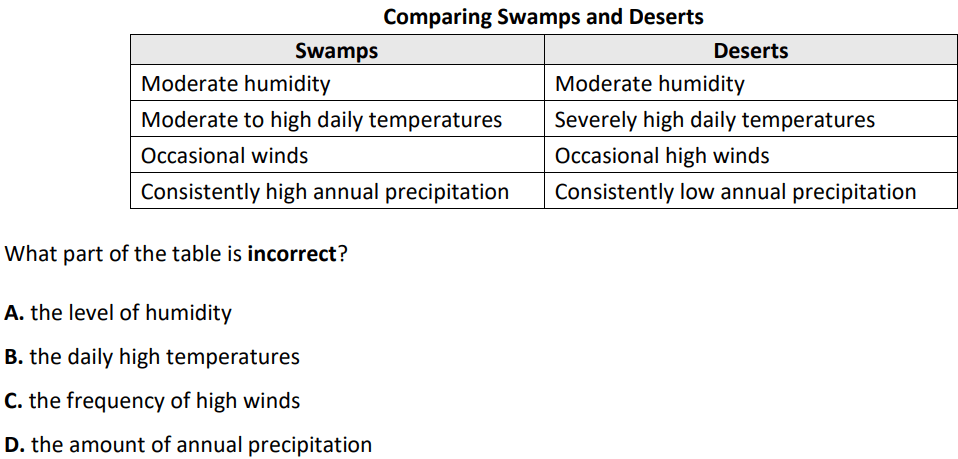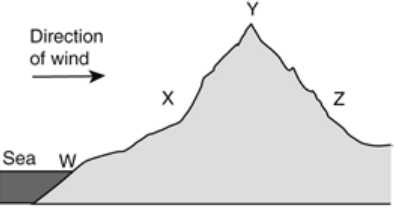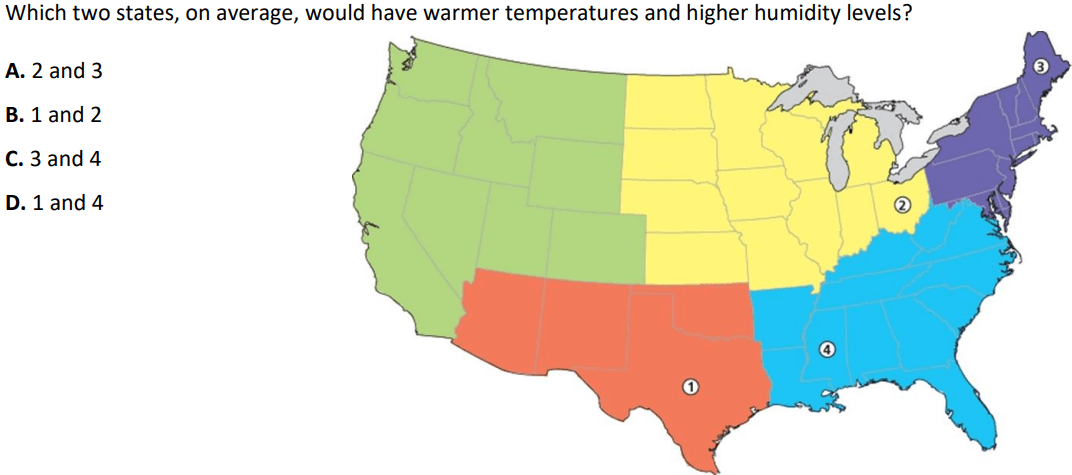Wetlands and rainforests have some similar weather factors; one is high humidity. What is another factor these two environments have in common?
A. low temperatures
B. high amounts of precipitation
C. low number of living things
D. high elevations
B. high amounts of precipitation
What weather conditions (humidity and temperature) would most likely be found in a polar climate zone?
dry (low humidity) and cold
List the 5 main factors of climate.
elevation (altitude)
latitude
proximity to water
ocean currents
global winds
How are desert and tundra environments similar?
The desert and tundra both have low amounts of precipitation.
Which climate zone is closest to the equator?
Which climate zone is farthest from the equator?
tropical (closest)
polar (farther)
Explain how proximity (closeness) to water affects an environment's climate.
Close proximity to water = moderate temperatures, more precipitation.
Farther from the water...colder and hotter!!!

A. the level of humidity
Which climate zone experiences the greatest variety of weather with the seasons of the year?
temperate zone
Which letter represents the location of the coldest temperature? WHY?

Y
The higher you go, more cold more snow!!!
Many rainforests are found in the tropics and some are found in cooler temperate zones. What makes a forest a rainforest?
They have higher humidity and a large amount of precipitation.
Which climate zone does this most likely describe?
-usually sunny with frequent summer rains, most of the year, it is warm and humid, never snows
tropical climate zone

D. 1 and 4
Double Jeopardy: WHY?
"The weather here is very different from Miami. It was warm and rainy when we first moved here, but now that winter is coming, it is cool and dry. We may even get snow soon."
Which type of environment is this most likely describing?
grassland
Deserts in the temperate zones can be extremely hot in the afternoon and below freezing at night. Which answer best explains why this happens?
A. Temperate deserts have higher rainfall than other kinds of deserts. Warm rain during the day produces warm breezes in the desert. Cooler rains at night draw warm air away from the desert.
B. Temperate deserts lack trees and grass. With no trees, the Sun shines directly down and causes it to get hot in the day, and with no grass, the heat can’t escape at night.
C. Temperate deserts are found at high elevations, where the Sun and the wind are much stronger. This creates less extreme temperature changes.
D. Temperate deserts have very little cloud cover and extremely low humidity. This means that more energy from the Sun reaches the desert in the day, but that heat can escape quickly at night.
Temperate deserts have very little cloud cover and extremely low humidity. This means that more energy from the Sun reaches the desert in the day, but that heat can escape quickly at night.
A student visits relatives who live in the Rocky Mountains. At the base of the mountains, the climate is warm with high humidity. As she moves up to a higher elevation, she notices that the climate changes. What happens to the climate as she moves up to a higher elevation?
A. The climate becomes warmer with even more humidity.
B. The climate becomes cooler with lower humidity.
C. The climate becomes warmer with lower humidity.
D. The climate becomes cooler with even more humidity.
B. The climate becomes cooler with lower humidity.